Business Law Report: Director Duties, Employment, and Disputes
VerifiedAdded on 2022/12/29
|11
|3718
|84
Report
AI Summary
This report delves into critical aspects of business law, presenting a comprehensive overview for business managers. It begins by examining the role of a director in a company, outlining their duties and responsibilities as per the Companies Act 2006, with a specific focus on the case of Gemme, the sole director of Clean Machine Limited. The report then explores employment law, particularly focusing on the dismissal and termination of employment contracts, using the scenario of Gemme's employee, Charanjit. It discusses the legal grounds for dismissal, fair dismissal processes, and the required notice periods. Finally, the report addresses different dispute resolution mechanisms that businesses can utilize, offering insights into resolving conflicts effectively. The report provides a practical guide to navigating business law complexities.
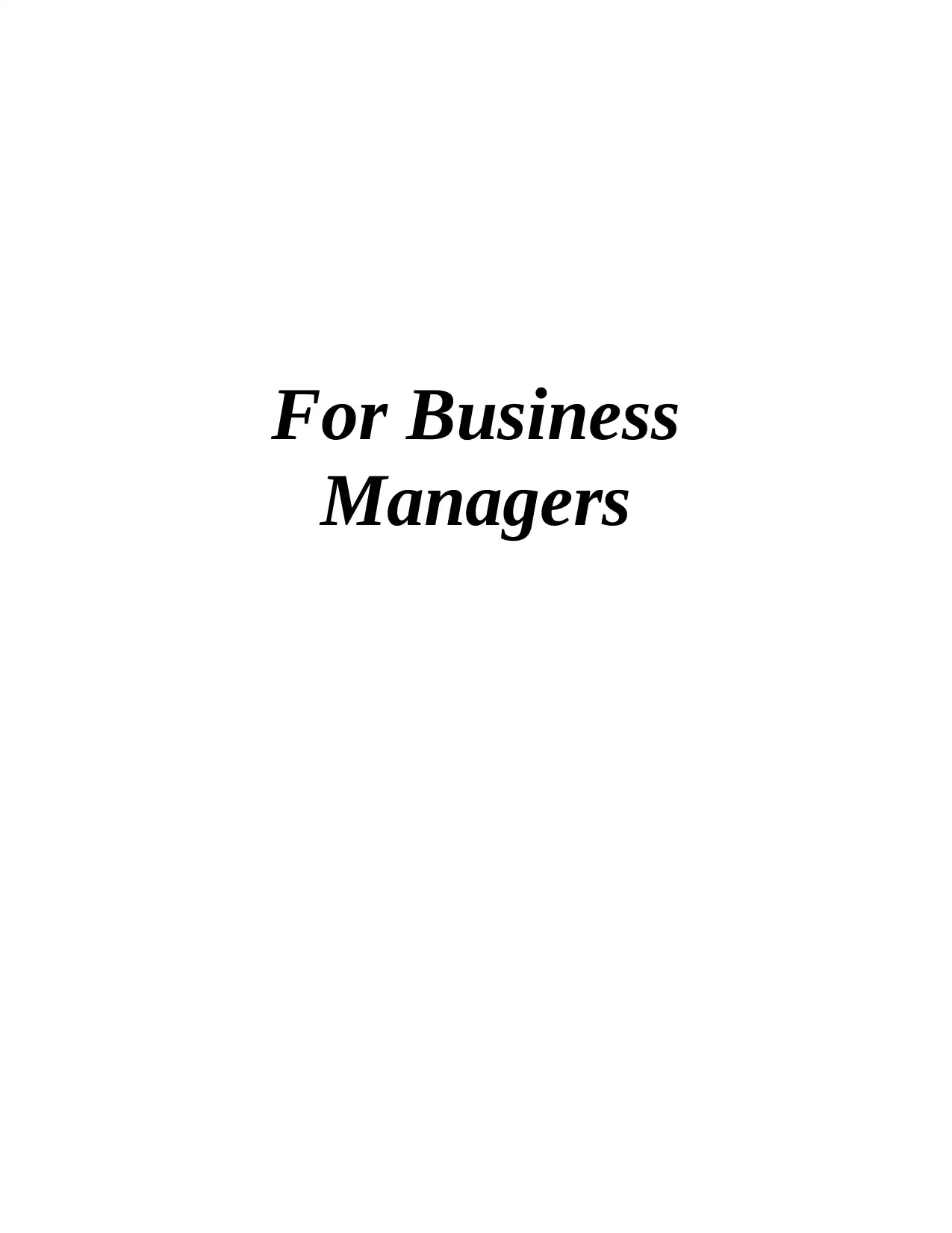
For Business
Managers
Managers
Paraphrase This Document
Need a fresh take? Get an instant paraphrase of this document with our AI Paraphraser
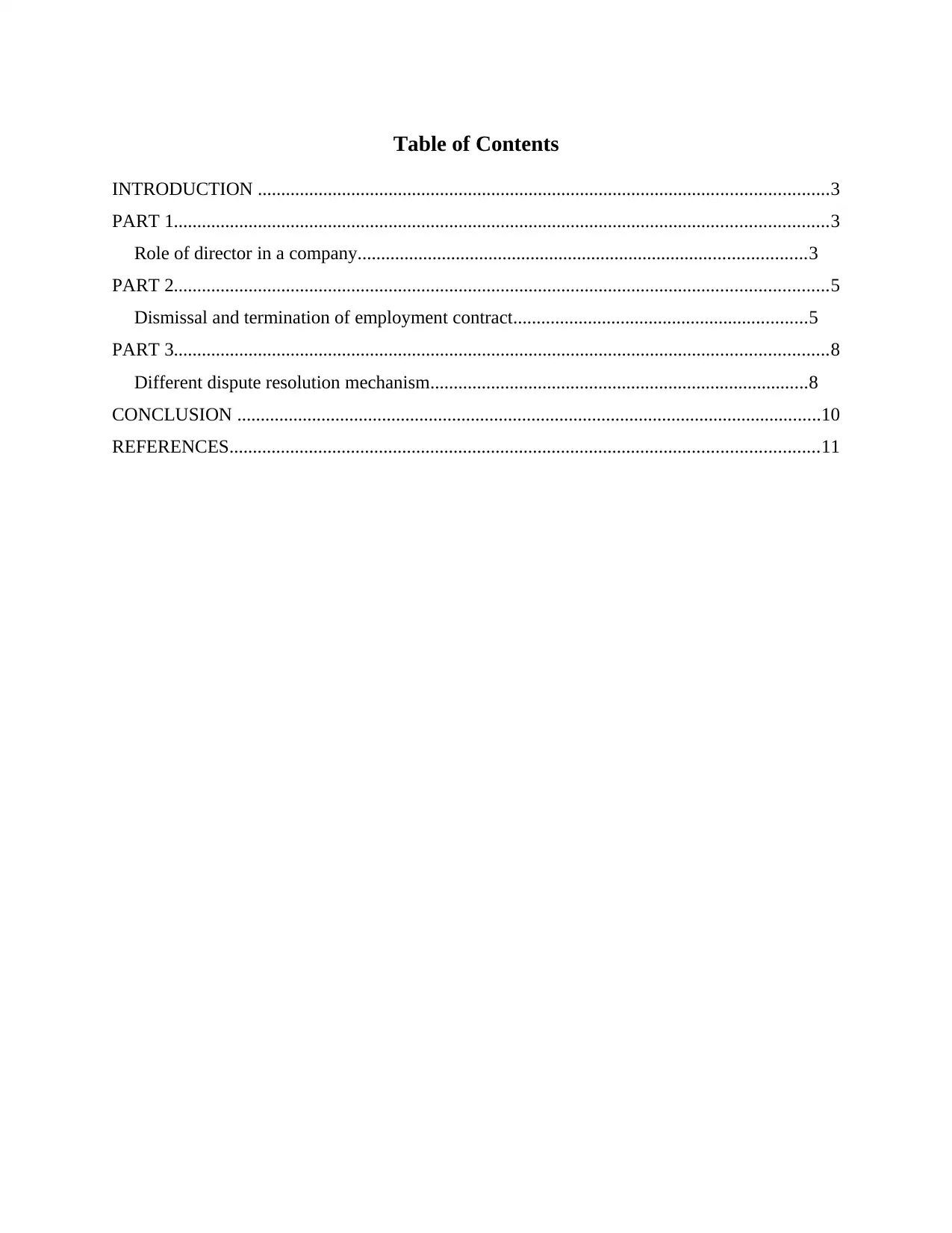
Table of Contents
INTRODUCTION ..........................................................................................................................3
PART 1............................................................................................................................................3
Role of director in a company................................................................................................3
PART 2............................................................................................................................................5
Dismissal and termination of employment contract...............................................................5
PART 3............................................................................................................................................8
Different dispute resolution mechanism.................................................................................8
CONCLUSION .............................................................................................................................10
REFERENCES..............................................................................................................................11
INTRODUCTION ..........................................................................................................................3
PART 1............................................................................................................................................3
Role of director in a company................................................................................................3
PART 2............................................................................................................................................5
Dismissal and termination of employment contract...............................................................5
PART 3............................................................................................................................................8
Different dispute resolution mechanism.................................................................................8
CONCLUSION .............................................................................................................................10
REFERENCES..............................................................................................................................11
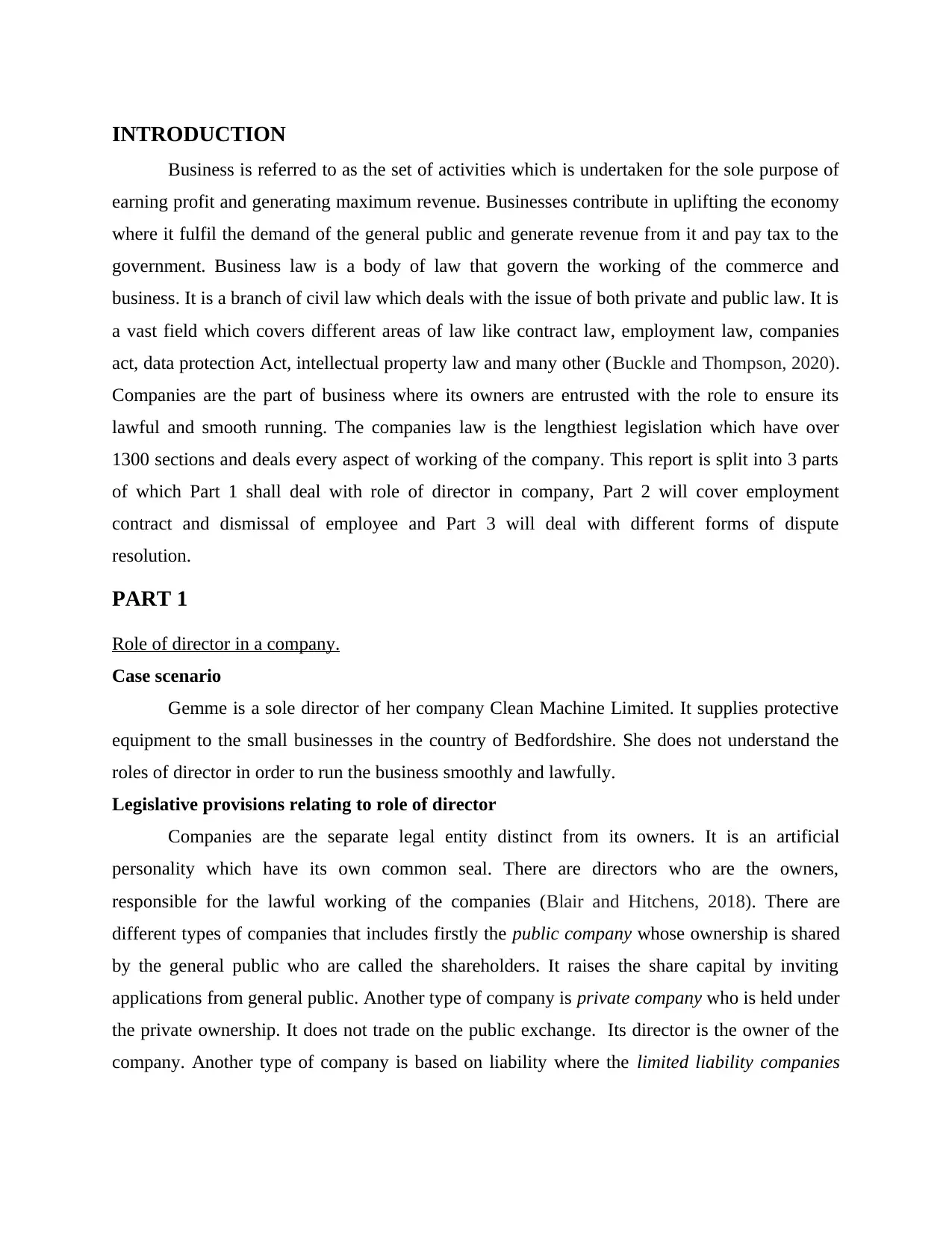
INTRODUCTION
Business is referred to as the set of activities which is undertaken for the sole purpose of
earning profit and generating maximum revenue. Businesses contribute in uplifting the economy
where it fulfil the demand of the general public and generate revenue from it and pay tax to the
government. Business law is a body of law that govern the working of the commerce and
business. It is a branch of civil law which deals with the issue of both private and public law. It is
a vast field which covers different areas of law like contract law, employment law, companies
act, data protection Act, intellectual property law and many other (Buckle and Thompson, 2020).
Companies are the part of business where its owners are entrusted with the role to ensure its
lawful and smooth running. The companies law is the lengthiest legislation which have over
1300 sections and deals every aspect of working of the company. This report is split into 3 parts
of which Part 1 shall deal with role of director in company, Part 2 will cover employment
contract and dismissal of employee and Part 3 will deal with different forms of dispute
resolution.
PART 1
Role of director in a company.
Case scenario
Gemme is a sole director of her company Clean Machine Limited. It supplies protective
equipment to the small businesses in the country of Bedfordshire. She does not understand the
roles of director in order to run the business smoothly and lawfully.
Legislative provisions relating to role of director
Companies are the separate legal entity distinct from its owners. It is an artificial
personality which have its own common seal. There are directors who are the owners,
responsible for the lawful working of the companies (Blair and Hitchens, 2018). There are
different types of companies that includes firstly the public company whose ownership is shared
by the general public who are called the shareholders. It raises the share capital by inviting
applications from general public. Another type of company is private company who is held under
the private ownership. It does not trade on the public exchange. Its director is the owner of the
company. Another type of company is based on liability where the limited liability companies
Business is referred to as the set of activities which is undertaken for the sole purpose of
earning profit and generating maximum revenue. Businesses contribute in uplifting the economy
where it fulfil the demand of the general public and generate revenue from it and pay tax to the
government. Business law is a body of law that govern the working of the commerce and
business. It is a branch of civil law which deals with the issue of both private and public law. It is
a vast field which covers different areas of law like contract law, employment law, companies
act, data protection Act, intellectual property law and many other (Buckle and Thompson, 2020).
Companies are the part of business where its owners are entrusted with the role to ensure its
lawful and smooth running. The companies law is the lengthiest legislation which have over
1300 sections and deals every aspect of working of the company. This report is split into 3 parts
of which Part 1 shall deal with role of director in company, Part 2 will cover employment
contract and dismissal of employee and Part 3 will deal with different forms of dispute
resolution.
PART 1
Role of director in a company.
Case scenario
Gemme is a sole director of her company Clean Machine Limited. It supplies protective
equipment to the small businesses in the country of Bedfordshire. She does not understand the
roles of director in order to run the business smoothly and lawfully.
Legislative provisions relating to role of director
Companies are the separate legal entity distinct from its owners. It is an artificial
personality which have its own common seal. There are directors who are the owners,
responsible for the lawful working of the companies (Blair and Hitchens, 2018). There are
different types of companies that includes firstly the public company whose ownership is shared
by the general public who are called the shareholders. It raises the share capital by inviting
applications from general public. Another type of company is private company who is held under
the private ownership. It does not trade on the public exchange. Its director is the owner of the
company. Another type of company is based on liability where the limited liability companies
⊘ This is a preview!⊘
Do you want full access?
Subscribe today to unlock all pages.

Trusted by 1+ million students worldwide
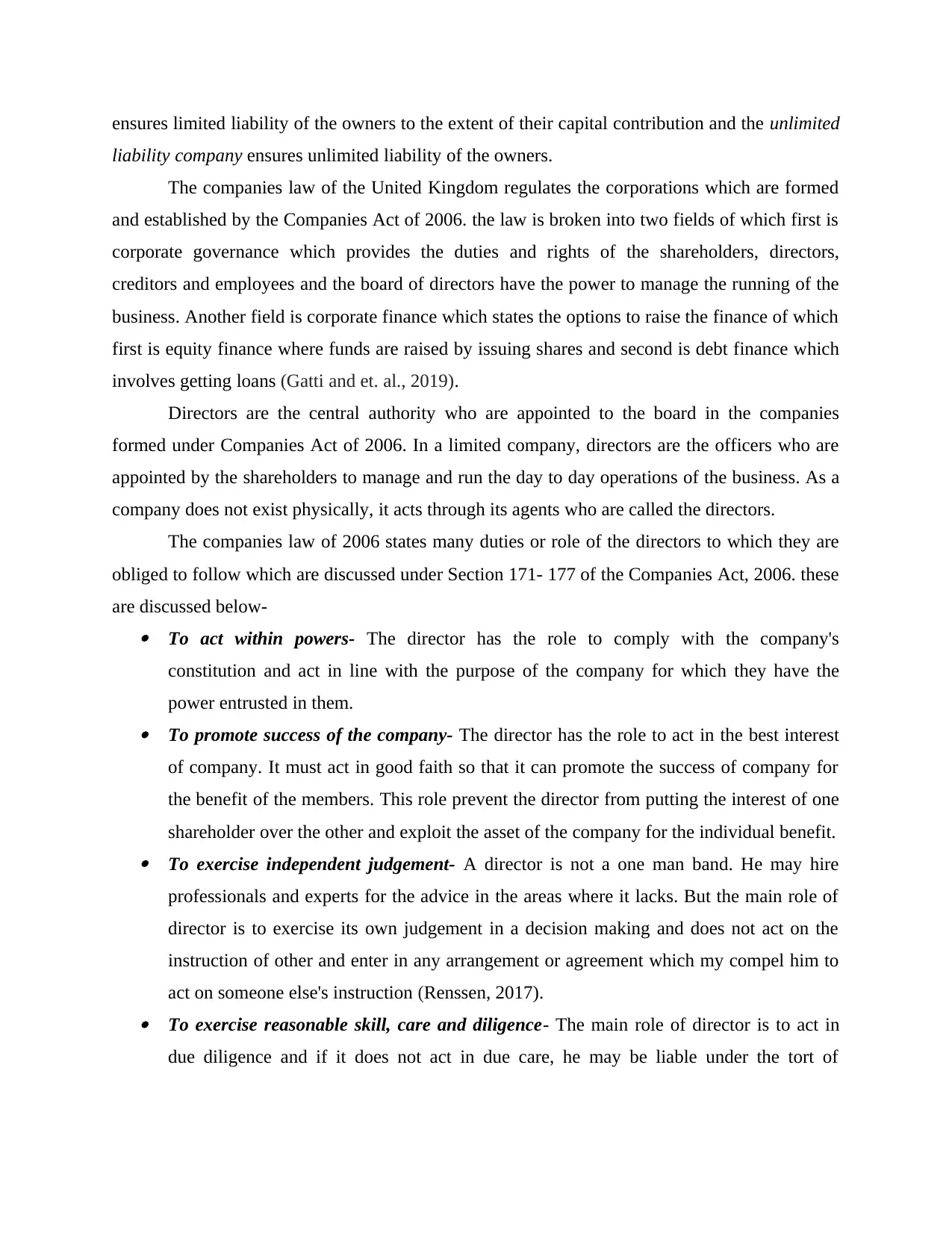
ensures limited liability of the owners to the extent of their capital contribution and the unlimited
liability company ensures unlimited liability of the owners.
The companies law of the United Kingdom regulates the corporations which are formed
and established by the Companies Act of 2006. the law is broken into two fields of which first is
corporate governance which provides the duties and rights of the shareholders, directors,
creditors and employees and the board of directors have the power to manage the running of the
business. Another field is corporate finance which states the options to raise the finance of which
first is equity finance where funds are raised by issuing shares and second is debt finance which
involves getting loans (Gatti and et. al., 2019).
Directors are the central authority who are appointed to the board in the companies
formed under Companies Act of 2006. In a limited company, directors are the officers who are
appointed by the shareholders to manage and run the day to day operations of the business. As a
company does not exist physically, it acts through its agents who are called the directors.
The companies law of 2006 states many duties or role of the directors to which they are
obliged to follow which are discussed under Section 171- 177 of the Companies Act, 2006. these
are discussed below- To act within powers- The director has the role to comply with the company's
constitution and act in line with the purpose of the company for which they have the
power entrusted in them. To promote success of the company- The director has the role to act in the best interest
of company. It must act in good faith so that it can promote the success of company for
the benefit of the members. This role prevent the director from putting the interest of one
shareholder over the other and exploit the asset of the company for the individual benefit. To exercise independent judgement- A director is not a one man band. He may hire
professionals and experts for the advice in the areas where it lacks. But the main role of
director is to exercise its own judgement in a decision making and does not act on the
instruction of other and enter in any arrangement or agreement which my compel him to
act on someone else's instruction (Renssen, 2017). To exercise reasonable skill, care and diligence- The main role of director is to act in
due diligence and if it does not act in due care, he may be liable under the tort of
liability company ensures unlimited liability of the owners.
The companies law of the United Kingdom regulates the corporations which are formed
and established by the Companies Act of 2006. the law is broken into two fields of which first is
corporate governance which provides the duties and rights of the shareholders, directors,
creditors and employees and the board of directors have the power to manage the running of the
business. Another field is corporate finance which states the options to raise the finance of which
first is equity finance where funds are raised by issuing shares and second is debt finance which
involves getting loans (Gatti and et. al., 2019).
Directors are the central authority who are appointed to the board in the companies
formed under Companies Act of 2006. In a limited company, directors are the officers who are
appointed by the shareholders to manage and run the day to day operations of the business. As a
company does not exist physically, it acts through its agents who are called the directors.
The companies law of 2006 states many duties or role of the directors to which they are
obliged to follow which are discussed under Section 171- 177 of the Companies Act, 2006. these
are discussed below- To act within powers- The director has the role to comply with the company's
constitution and act in line with the purpose of the company for which they have the
power entrusted in them. To promote success of the company- The director has the role to act in the best interest
of company. It must act in good faith so that it can promote the success of company for
the benefit of the members. This role prevent the director from putting the interest of one
shareholder over the other and exploit the asset of the company for the individual benefit. To exercise independent judgement- A director is not a one man band. He may hire
professionals and experts for the advice in the areas where it lacks. But the main role of
director is to exercise its own judgement in a decision making and does not act on the
instruction of other and enter in any arrangement or agreement which my compel him to
act on someone else's instruction (Renssen, 2017). To exercise reasonable skill, care and diligence- The main role of director is to act in
due diligence and if it does not act in due care, he may be liable under the tort of
Paraphrase This Document
Need a fresh take? Get an instant paraphrase of this document with our AI Paraphraser
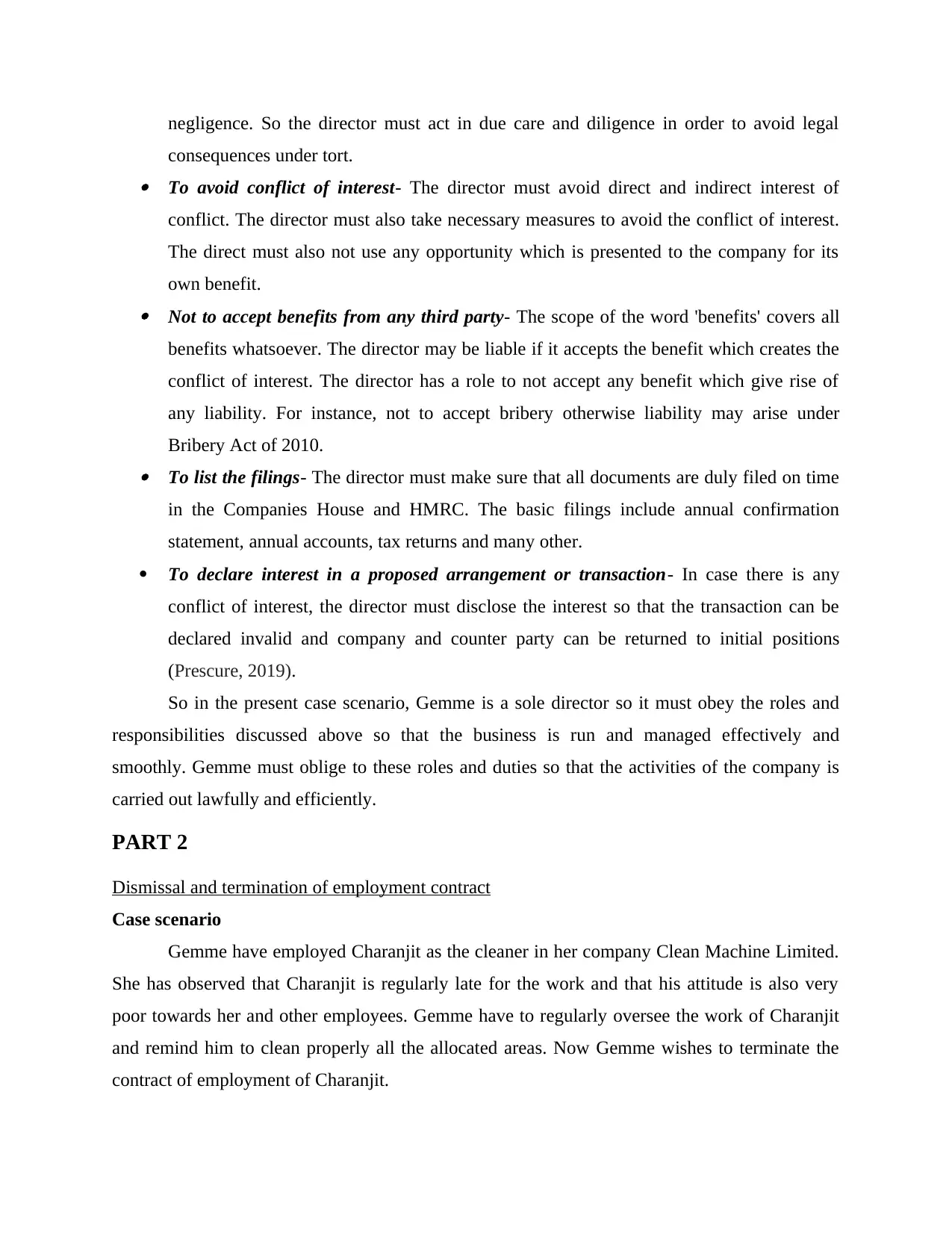
negligence. So the director must act in due care and diligence in order to avoid legal
consequences under tort. To avoid conflict of interest- The director must avoid direct and indirect interest of
conflict. The director must also take necessary measures to avoid the conflict of interest.
The direct must also not use any opportunity which is presented to the company for its
own benefit. Not to accept benefits from any third party- The scope of the word 'benefits' covers all
benefits whatsoever. The director may be liable if it accepts the benefit which creates the
conflict of interest. The director has a role to not accept any benefit which give rise of
any liability. For instance, not to accept bribery otherwise liability may arise under
Bribery Act of 2010. To list the filings- The director must make sure that all documents are duly filed on time
in the Companies House and HMRC. The basic filings include annual confirmation
statement, annual accounts, tax returns and many other.
To declare interest in a proposed arrangement or transaction- In case there is any
conflict of interest, the director must disclose the interest so that the transaction can be
declared invalid and company and counter party can be returned to initial positions
(Prescure, 2019).
So in the present case scenario, Gemme is a sole director so it must obey the roles and
responsibilities discussed above so that the business is run and managed effectively and
smoothly. Gemme must oblige to these roles and duties so that the activities of the company is
carried out lawfully and efficiently.
PART 2
Dismissal and termination of employment contract
Case scenario
Gemme have employed Charanjit as the cleaner in her company Clean Machine Limited.
She has observed that Charanjit is regularly late for the work and that his attitude is also very
poor towards her and other employees. Gemme have to regularly oversee the work of Charanjit
and remind him to clean properly all the allocated areas. Now Gemme wishes to terminate the
contract of employment of Charanjit.
consequences under tort. To avoid conflict of interest- The director must avoid direct and indirect interest of
conflict. The director must also take necessary measures to avoid the conflict of interest.
The direct must also not use any opportunity which is presented to the company for its
own benefit. Not to accept benefits from any third party- The scope of the word 'benefits' covers all
benefits whatsoever. The director may be liable if it accepts the benefit which creates the
conflict of interest. The director has a role to not accept any benefit which give rise of
any liability. For instance, not to accept bribery otherwise liability may arise under
Bribery Act of 2010. To list the filings- The director must make sure that all documents are duly filed on time
in the Companies House and HMRC. The basic filings include annual confirmation
statement, annual accounts, tax returns and many other.
To declare interest in a proposed arrangement or transaction- In case there is any
conflict of interest, the director must disclose the interest so that the transaction can be
declared invalid and company and counter party can be returned to initial positions
(Prescure, 2019).
So in the present case scenario, Gemme is a sole director so it must obey the roles and
responsibilities discussed above so that the business is run and managed effectively and
smoothly. Gemme must oblige to these roles and duties so that the activities of the company is
carried out lawfully and efficiently.
PART 2
Dismissal and termination of employment contract
Case scenario
Gemme have employed Charanjit as the cleaner in her company Clean Machine Limited.
She has observed that Charanjit is regularly late for the work and that his attitude is also very
poor towards her and other employees. Gemme have to regularly oversee the work of Charanjit
and remind him to clean properly all the allocated areas. Now Gemme wishes to terminate the
contract of employment of Charanjit.
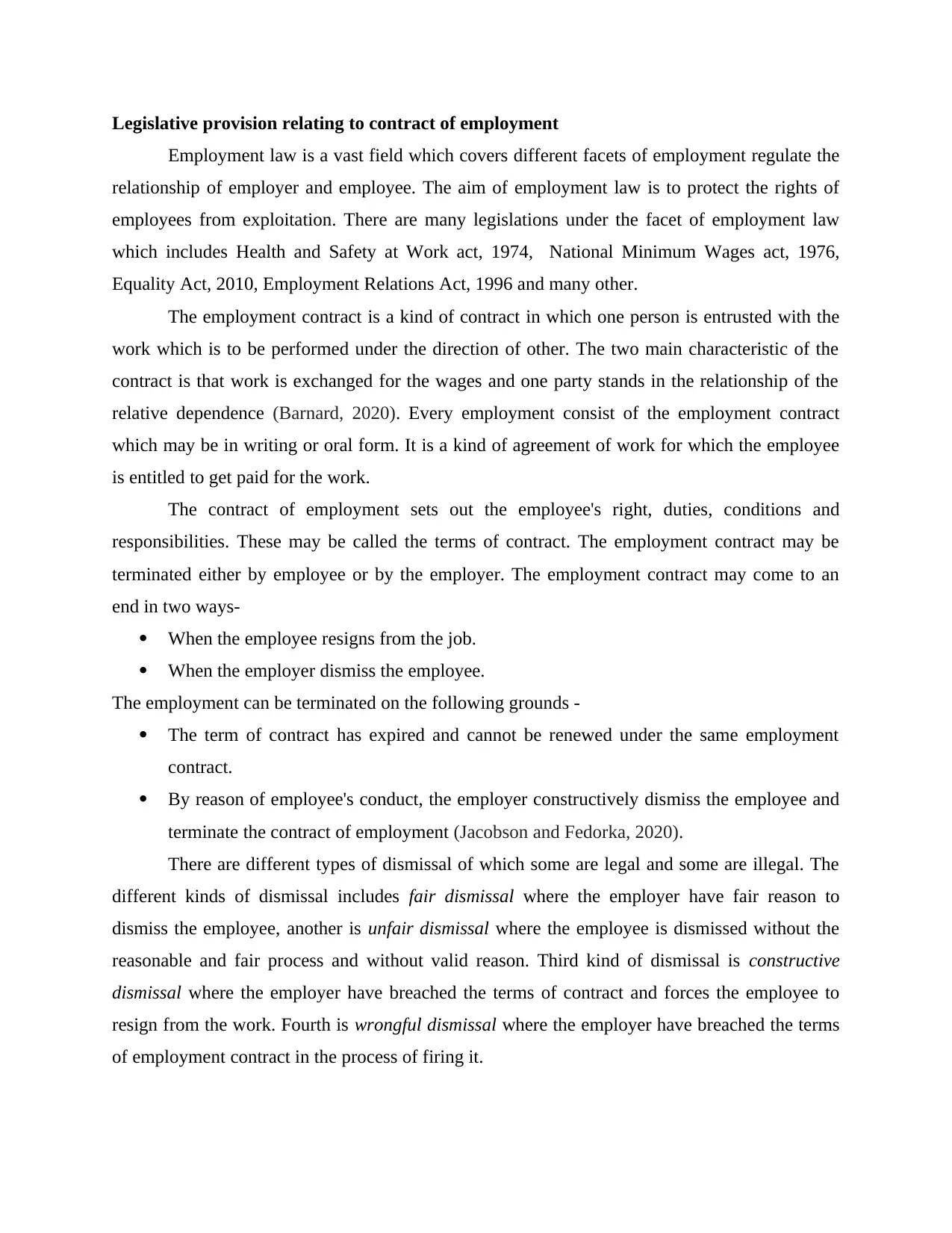
Legislative provision relating to contract of employment
Employment law is a vast field which covers different facets of employment regulate the
relationship of employer and employee. The aim of employment law is to protect the rights of
employees from exploitation. There are many legislations under the facet of employment law
which includes Health and Safety at Work act, 1974, National Minimum Wages act, 1976,
Equality Act, 2010, Employment Relations Act, 1996 and many other.
The employment contract is a kind of contract in which one person is entrusted with the
work which is to be performed under the direction of other. The two main characteristic of the
contract is that work is exchanged for the wages and one party stands in the relationship of the
relative dependence (Barnard, 2020). Every employment consist of the employment contract
which may be in writing or oral form. It is a kind of agreement of work for which the employee
is entitled to get paid for the work.
The contract of employment sets out the employee's right, duties, conditions and
responsibilities. These may be called the terms of contract. The employment contract may be
terminated either by employee or by the employer. The employment contract may come to an
end in two ways-
When the employee resigns from the job.
When the employer dismiss the employee.
The employment can be terminated on the following grounds -
The term of contract has expired and cannot be renewed under the same employment
contract.
By reason of employee's conduct, the employer constructively dismiss the employee and
terminate the contract of employment (Jacobson and Fedorka, 2020).
There are different types of dismissal of which some are legal and some are illegal. The
different kinds of dismissal includes fair dismissal where the employer have fair reason to
dismiss the employee, another is unfair dismissal where the employee is dismissed without the
reasonable and fair process and without valid reason. Third kind of dismissal is constructive
dismissal where the employer have breached the terms of contract and forces the employee to
resign from the work. Fourth is wrongful dismissal where the employer have breached the terms
of employment contract in the process of firing it.
Employment law is a vast field which covers different facets of employment regulate the
relationship of employer and employee. The aim of employment law is to protect the rights of
employees from exploitation. There are many legislations under the facet of employment law
which includes Health and Safety at Work act, 1974, National Minimum Wages act, 1976,
Equality Act, 2010, Employment Relations Act, 1996 and many other.
The employment contract is a kind of contract in which one person is entrusted with the
work which is to be performed under the direction of other. The two main characteristic of the
contract is that work is exchanged for the wages and one party stands in the relationship of the
relative dependence (Barnard, 2020). Every employment consist of the employment contract
which may be in writing or oral form. It is a kind of agreement of work for which the employee
is entitled to get paid for the work.
The contract of employment sets out the employee's right, duties, conditions and
responsibilities. These may be called the terms of contract. The employment contract may be
terminated either by employee or by the employer. The employment contract may come to an
end in two ways-
When the employee resigns from the job.
When the employer dismiss the employee.
The employment can be terminated on the following grounds -
The term of contract has expired and cannot be renewed under the same employment
contract.
By reason of employee's conduct, the employer constructively dismiss the employee and
terminate the contract of employment (Jacobson and Fedorka, 2020).
There are different types of dismissal of which some are legal and some are illegal. The
different kinds of dismissal includes fair dismissal where the employer have fair reason to
dismiss the employee, another is unfair dismissal where the employee is dismissed without the
reasonable and fair process and without valid reason. Third kind of dismissal is constructive
dismissal where the employer have breached the terms of contract and forces the employee to
resign from the work. Fourth is wrongful dismissal where the employer have breached the terms
of employment contract in the process of firing it.
⊘ This is a preview!⊘
Do you want full access?
Subscribe today to unlock all pages.

Trusted by 1+ million students worldwide
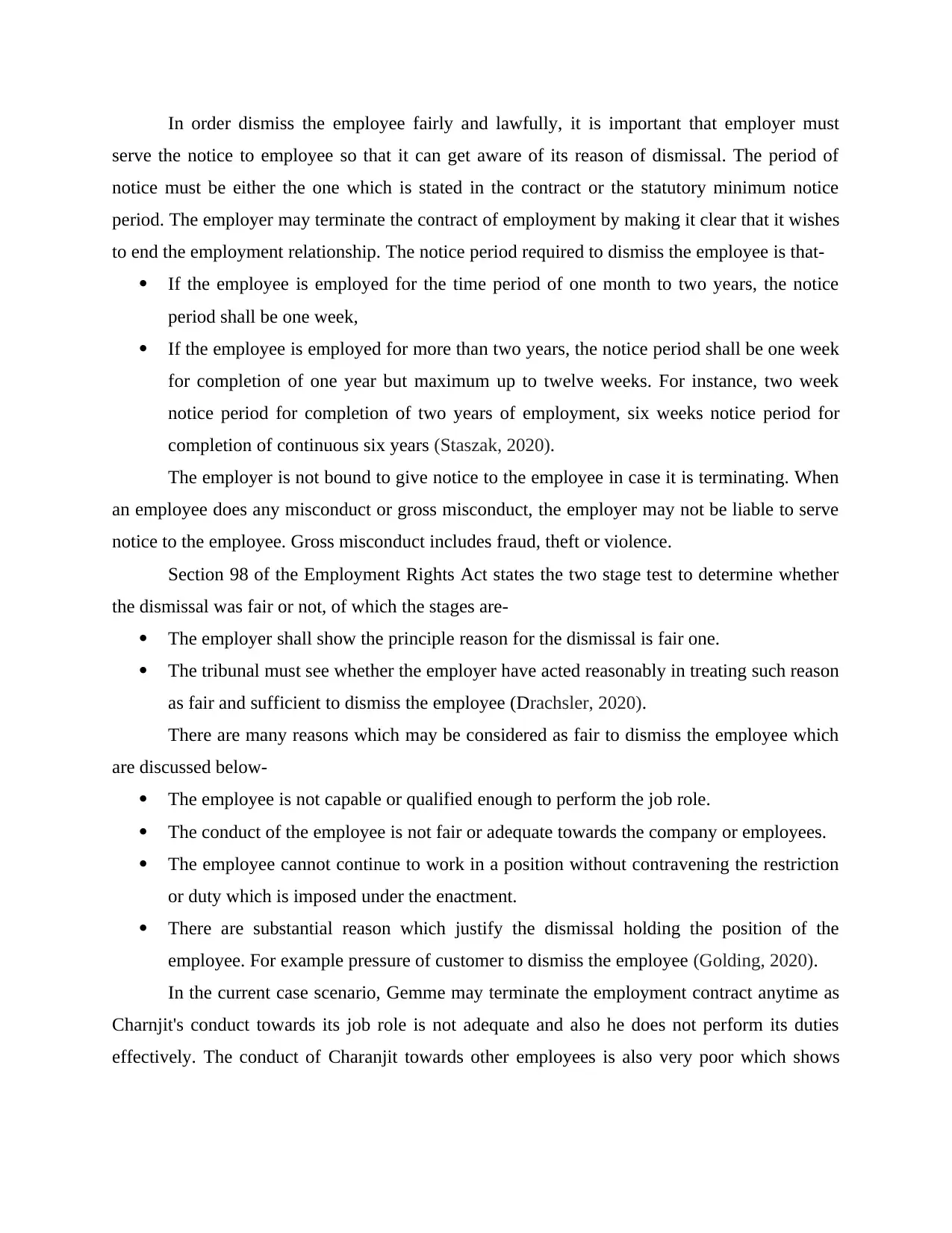
In order dismiss the employee fairly and lawfully, it is important that employer must
serve the notice to employee so that it can get aware of its reason of dismissal. The period of
notice must be either the one which is stated in the contract or the statutory minimum notice
period. The employer may terminate the contract of employment by making it clear that it wishes
to end the employment relationship. The notice period required to dismiss the employee is that-
If the employee is employed for the time period of one month to two years, the notice
period shall be one week,
If the employee is employed for more than two years, the notice period shall be one week
for completion of one year but maximum up to twelve weeks. For instance, two week
notice period for completion of two years of employment, six weeks notice period for
completion of continuous six years (Staszak, 2020).
The employer is not bound to give notice to the employee in case it is terminating. When
an employee does any misconduct or gross misconduct, the employer may not be liable to serve
notice to the employee. Gross misconduct includes fraud, theft or violence.
Section 98 of the Employment Rights Act states the two stage test to determine whether
the dismissal was fair or not, of which the stages are-
The employer shall show the principle reason for the dismissal is fair one.
The tribunal must see whether the employer have acted reasonably in treating such reason
as fair and sufficient to dismiss the employee (Drachsler, 2020).
There are many reasons which may be considered as fair to dismiss the employee which
are discussed below-
The employee is not capable or qualified enough to perform the job role.
The conduct of the employee is not fair or adequate towards the company or employees.
The employee cannot continue to work in a position without contravening the restriction
or duty which is imposed under the enactment.
There are substantial reason which justify the dismissal holding the position of the
employee. For example pressure of customer to dismiss the employee (Golding, 2020).
In the current case scenario, Gemme may terminate the employment contract anytime as
Charnjit's conduct towards its job role is not adequate and also he does not perform its duties
effectively. The conduct of Charanjit towards other employees is also very poor which shows
serve the notice to employee so that it can get aware of its reason of dismissal. The period of
notice must be either the one which is stated in the contract or the statutory minimum notice
period. The employer may terminate the contract of employment by making it clear that it wishes
to end the employment relationship. The notice period required to dismiss the employee is that-
If the employee is employed for the time period of one month to two years, the notice
period shall be one week,
If the employee is employed for more than two years, the notice period shall be one week
for completion of one year but maximum up to twelve weeks. For instance, two week
notice period for completion of two years of employment, six weeks notice period for
completion of continuous six years (Staszak, 2020).
The employer is not bound to give notice to the employee in case it is terminating. When
an employee does any misconduct or gross misconduct, the employer may not be liable to serve
notice to the employee. Gross misconduct includes fraud, theft or violence.
Section 98 of the Employment Rights Act states the two stage test to determine whether
the dismissal was fair or not, of which the stages are-
The employer shall show the principle reason for the dismissal is fair one.
The tribunal must see whether the employer have acted reasonably in treating such reason
as fair and sufficient to dismiss the employee (Drachsler, 2020).
There are many reasons which may be considered as fair to dismiss the employee which
are discussed below-
The employee is not capable or qualified enough to perform the job role.
The conduct of the employee is not fair or adequate towards the company or employees.
The employee cannot continue to work in a position without contravening the restriction
or duty which is imposed under the enactment.
There are substantial reason which justify the dismissal holding the position of the
employee. For example pressure of customer to dismiss the employee (Golding, 2020).
In the current case scenario, Gemme may terminate the employment contract anytime as
Charnjit's conduct towards its job role is not adequate and also he does not perform its duties
effectively. The conduct of Charanjit towards other employees is also very poor which shows
Paraphrase This Document
Need a fresh take? Get an instant paraphrase of this document with our AI Paraphraser
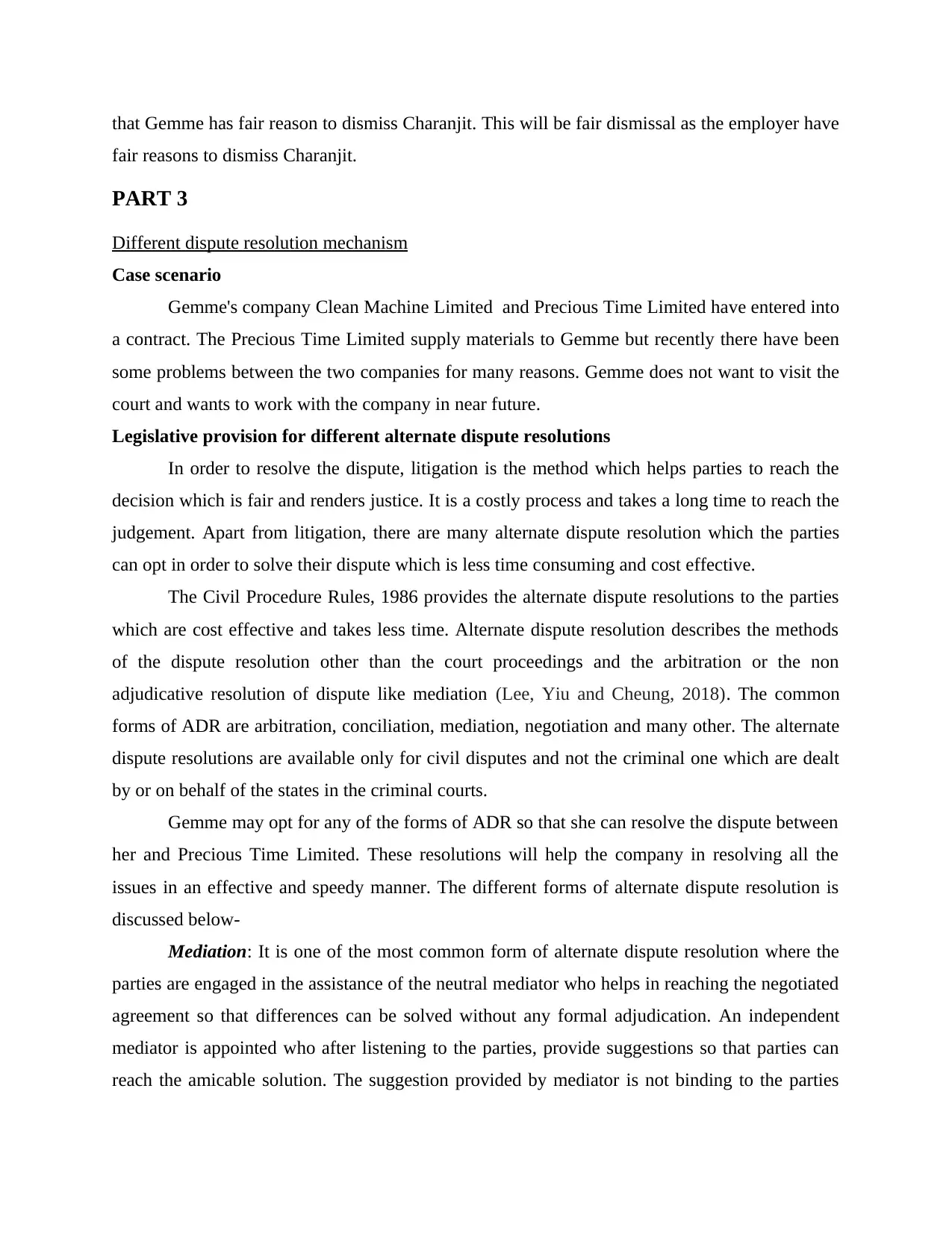
that Gemme has fair reason to dismiss Charanjit. This will be fair dismissal as the employer have
fair reasons to dismiss Charanjit.
PART 3
Different dispute resolution mechanism
Case scenario
Gemme's company Clean Machine Limited and Precious Time Limited have entered into
a contract. The Precious Time Limited supply materials to Gemme but recently there have been
some problems between the two companies for many reasons. Gemme does not want to visit the
court and wants to work with the company in near future.
Legislative provision for different alternate dispute resolutions
In order to resolve the dispute, litigation is the method which helps parties to reach the
decision which is fair and renders justice. It is a costly process and takes a long time to reach the
judgement. Apart from litigation, there are many alternate dispute resolution which the parties
can opt in order to solve their dispute which is less time consuming and cost effective.
The Civil Procedure Rules, 1986 provides the alternate dispute resolutions to the parties
which are cost effective and takes less time. Alternate dispute resolution describes the methods
of the dispute resolution other than the court proceedings and the arbitration or the non
adjudicative resolution of dispute like mediation (Lee, Yiu and Cheung, 2018). The common
forms of ADR are arbitration, conciliation, mediation, negotiation and many other. The alternate
dispute resolutions are available only for civil disputes and not the criminal one which are dealt
by or on behalf of the states in the criminal courts.
Gemme may opt for any of the forms of ADR so that she can resolve the dispute between
her and Precious Time Limited. These resolutions will help the company in resolving all the
issues in an effective and speedy manner. The different forms of alternate dispute resolution is
discussed below-
Mediation: It is one of the most common form of alternate dispute resolution where the
parties are engaged in the assistance of the neutral mediator who helps in reaching the negotiated
agreement so that differences can be solved without any formal adjudication. An independent
mediator is appointed who after listening to the parties, provide suggestions so that parties can
reach the amicable solution. The suggestion provided by mediator is not binding to the parties
fair reasons to dismiss Charanjit.
PART 3
Different dispute resolution mechanism
Case scenario
Gemme's company Clean Machine Limited and Precious Time Limited have entered into
a contract. The Precious Time Limited supply materials to Gemme but recently there have been
some problems between the two companies for many reasons. Gemme does not want to visit the
court and wants to work with the company in near future.
Legislative provision for different alternate dispute resolutions
In order to resolve the dispute, litigation is the method which helps parties to reach the
decision which is fair and renders justice. It is a costly process and takes a long time to reach the
judgement. Apart from litigation, there are many alternate dispute resolution which the parties
can opt in order to solve their dispute which is less time consuming and cost effective.
The Civil Procedure Rules, 1986 provides the alternate dispute resolutions to the parties
which are cost effective and takes less time. Alternate dispute resolution describes the methods
of the dispute resolution other than the court proceedings and the arbitration or the non
adjudicative resolution of dispute like mediation (Lee, Yiu and Cheung, 2018). The common
forms of ADR are arbitration, conciliation, mediation, negotiation and many other. The alternate
dispute resolutions are available only for civil disputes and not the criminal one which are dealt
by or on behalf of the states in the criminal courts.
Gemme may opt for any of the forms of ADR so that she can resolve the dispute between
her and Precious Time Limited. These resolutions will help the company in resolving all the
issues in an effective and speedy manner. The different forms of alternate dispute resolution is
discussed below-
Mediation: It is one of the most common form of alternate dispute resolution where the
parties are engaged in the assistance of the neutral mediator who helps in reaching the negotiated
agreement so that differences can be solved without any formal adjudication. An independent
mediator is appointed who after listening to the parties, provide suggestions so that parties can
reach the amicable solution. The suggestion provided by mediator is not binding to the parties
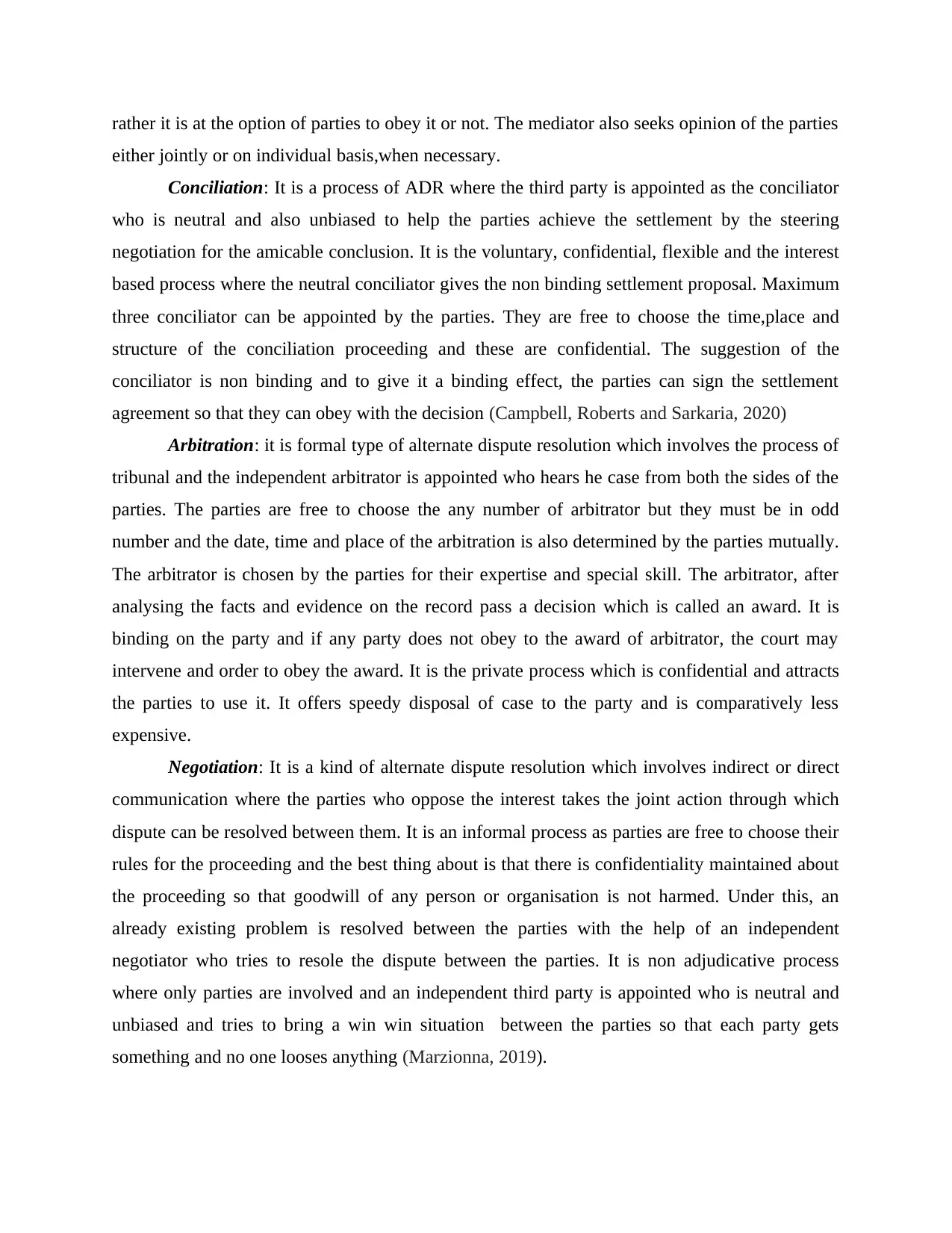
rather it is at the option of parties to obey it or not. The mediator also seeks opinion of the parties
either jointly or on individual basis,when necessary.
Conciliation: It is a process of ADR where the third party is appointed as the conciliator
who is neutral and also unbiased to help the parties achieve the settlement by the steering
negotiation for the amicable conclusion. It is the voluntary, confidential, flexible and the interest
based process where the neutral conciliator gives the non binding settlement proposal. Maximum
three conciliator can be appointed by the parties. They are free to choose the time,place and
structure of the conciliation proceeding and these are confidential. The suggestion of the
conciliator is non binding and to give it a binding effect, the parties can sign the settlement
agreement so that they can obey with the decision (Campbell, Roberts and Sarkaria, 2020)
Arbitration: it is formal type of alternate dispute resolution which involves the process of
tribunal and the independent arbitrator is appointed who hears he case from both the sides of the
parties. The parties are free to choose the any number of arbitrator but they must be in odd
number and the date, time and place of the arbitration is also determined by the parties mutually.
The arbitrator is chosen by the parties for their expertise and special skill. The arbitrator, after
analysing the facts and evidence on the record pass a decision which is called an award. It is
binding on the party and if any party does not obey to the award of arbitrator, the court may
intervene and order to obey the award. It is the private process which is confidential and attracts
the parties to use it. It offers speedy disposal of case to the party and is comparatively less
expensive.
Negotiation: It is a kind of alternate dispute resolution which involves indirect or direct
communication where the parties who oppose the interest takes the joint action through which
dispute can be resolved between them. It is an informal process as parties are free to choose their
rules for the proceeding and the best thing about is that there is confidentiality maintained about
the proceeding so that goodwill of any person or organisation is not harmed. Under this, an
already existing problem is resolved between the parties with the help of an independent
negotiator who tries to resole the dispute between the parties. It is non adjudicative process
where only parties are involved and an independent third party is appointed who is neutral and
unbiased and tries to bring a win win situation between the parties so that each party gets
something and no one looses anything (Marzionna, 2019).
either jointly or on individual basis,when necessary.
Conciliation: It is a process of ADR where the third party is appointed as the conciliator
who is neutral and also unbiased to help the parties achieve the settlement by the steering
negotiation for the amicable conclusion. It is the voluntary, confidential, flexible and the interest
based process where the neutral conciliator gives the non binding settlement proposal. Maximum
three conciliator can be appointed by the parties. They are free to choose the time,place and
structure of the conciliation proceeding and these are confidential. The suggestion of the
conciliator is non binding and to give it a binding effect, the parties can sign the settlement
agreement so that they can obey with the decision (Campbell, Roberts and Sarkaria, 2020)
Arbitration: it is formal type of alternate dispute resolution which involves the process of
tribunal and the independent arbitrator is appointed who hears he case from both the sides of the
parties. The parties are free to choose the any number of arbitrator but they must be in odd
number and the date, time and place of the arbitration is also determined by the parties mutually.
The arbitrator is chosen by the parties for their expertise and special skill. The arbitrator, after
analysing the facts and evidence on the record pass a decision which is called an award. It is
binding on the party and if any party does not obey to the award of arbitrator, the court may
intervene and order to obey the award. It is the private process which is confidential and attracts
the parties to use it. It offers speedy disposal of case to the party and is comparatively less
expensive.
Negotiation: It is a kind of alternate dispute resolution which involves indirect or direct
communication where the parties who oppose the interest takes the joint action through which
dispute can be resolved between them. It is an informal process as parties are free to choose their
rules for the proceeding and the best thing about is that there is confidentiality maintained about
the proceeding so that goodwill of any person or organisation is not harmed. Under this, an
already existing problem is resolved between the parties with the help of an independent
negotiator who tries to resole the dispute between the parties. It is non adjudicative process
where only parties are involved and an independent third party is appointed who is neutral and
unbiased and tries to bring a win win situation between the parties so that each party gets
something and no one looses anything (Marzionna, 2019).
⊘ This is a preview!⊘
Do you want full access?
Subscribe today to unlock all pages.

Trusted by 1+ million students worldwide
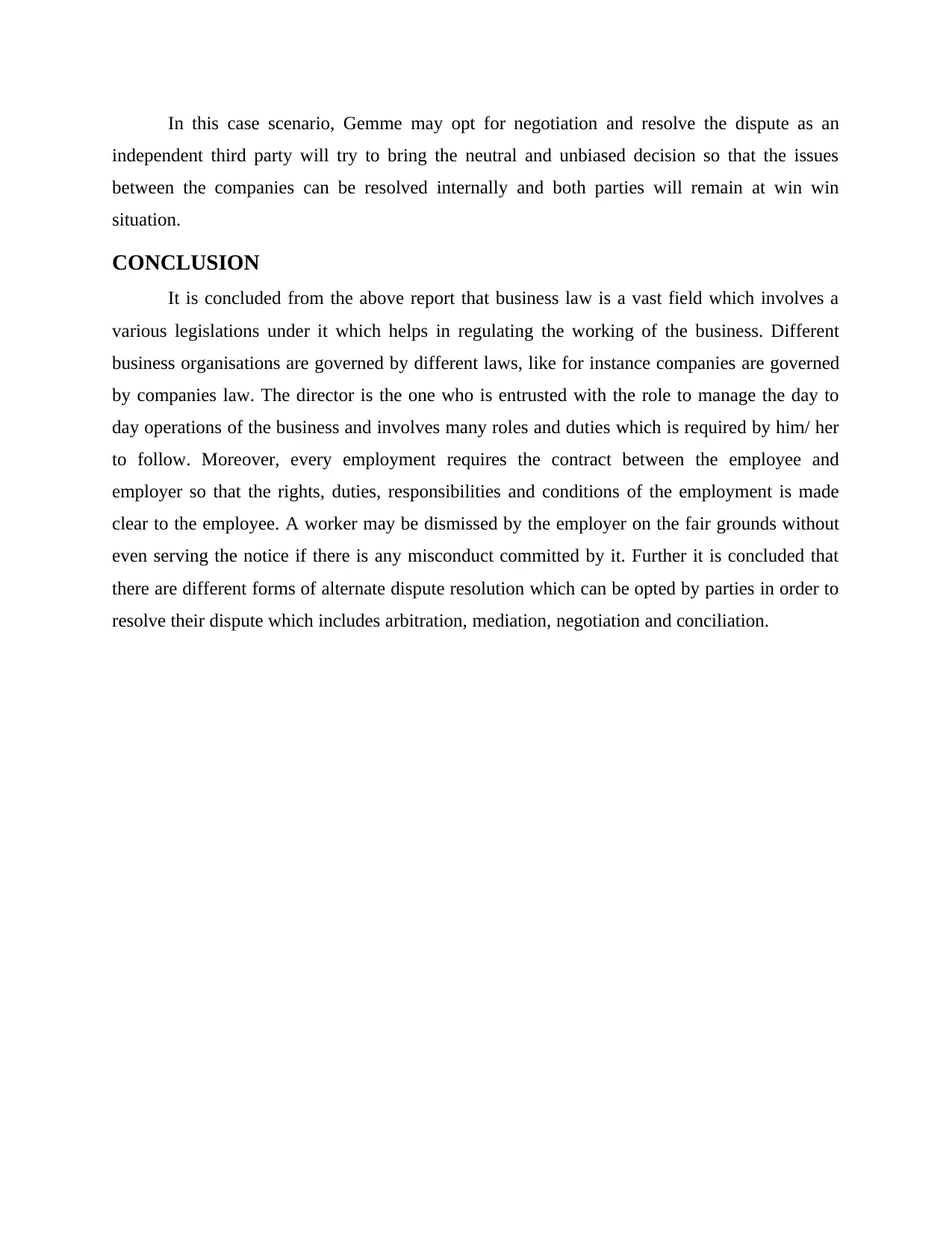
In this case scenario, Gemme may opt for negotiation and resolve the dispute as an
independent third party will try to bring the neutral and unbiased decision so that the issues
between the companies can be resolved internally and both parties will remain at win win
situation.
CONCLUSION
It is concluded from the above report that business law is a vast field which involves a
various legislations under it which helps in regulating the working of the business. Different
business organisations are governed by different laws, like for instance companies are governed
by companies law. The director is the one who is entrusted with the role to manage the day to
day operations of the business and involves many roles and duties which is required by him/ her
to follow. Moreover, every employment requires the contract between the employee and
employer so that the rights, duties, responsibilities and conditions of the employment is made
clear to the employee. A worker may be dismissed by the employer on the fair grounds without
even serving the notice if there is any misconduct committed by it. Further it is concluded that
there are different forms of alternate dispute resolution which can be opted by parties in order to
resolve their dispute which includes arbitration, mediation, negotiation and conciliation.
independent third party will try to bring the neutral and unbiased decision so that the issues
between the companies can be resolved internally and both parties will remain at win win
situation.
CONCLUSION
It is concluded from the above report that business law is a vast field which involves a
various legislations under it which helps in regulating the working of the business. Different
business organisations are governed by different laws, like for instance companies are governed
by companies law. The director is the one who is entrusted with the role to manage the day to
day operations of the business and involves many roles and duties which is required by him/ her
to follow. Moreover, every employment requires the contract between the employee and
employer so that the rights, duties, responsibilities and conditions of the employment is made
clear to the employee. A worker may be dismissed by the employer on the fair grounds without
even serving the notice if there is any misconduct committed by it. Further it is concluded that
there are different forms of alternate dispute resolution which can be opted by parties in order to
resolve their dispute which includes arbitration, mediation, negotiation and conciliation.
Paraphrase This Document
Need a fresh take? Get an instant paraphrase of this document with our AI Paraphraser
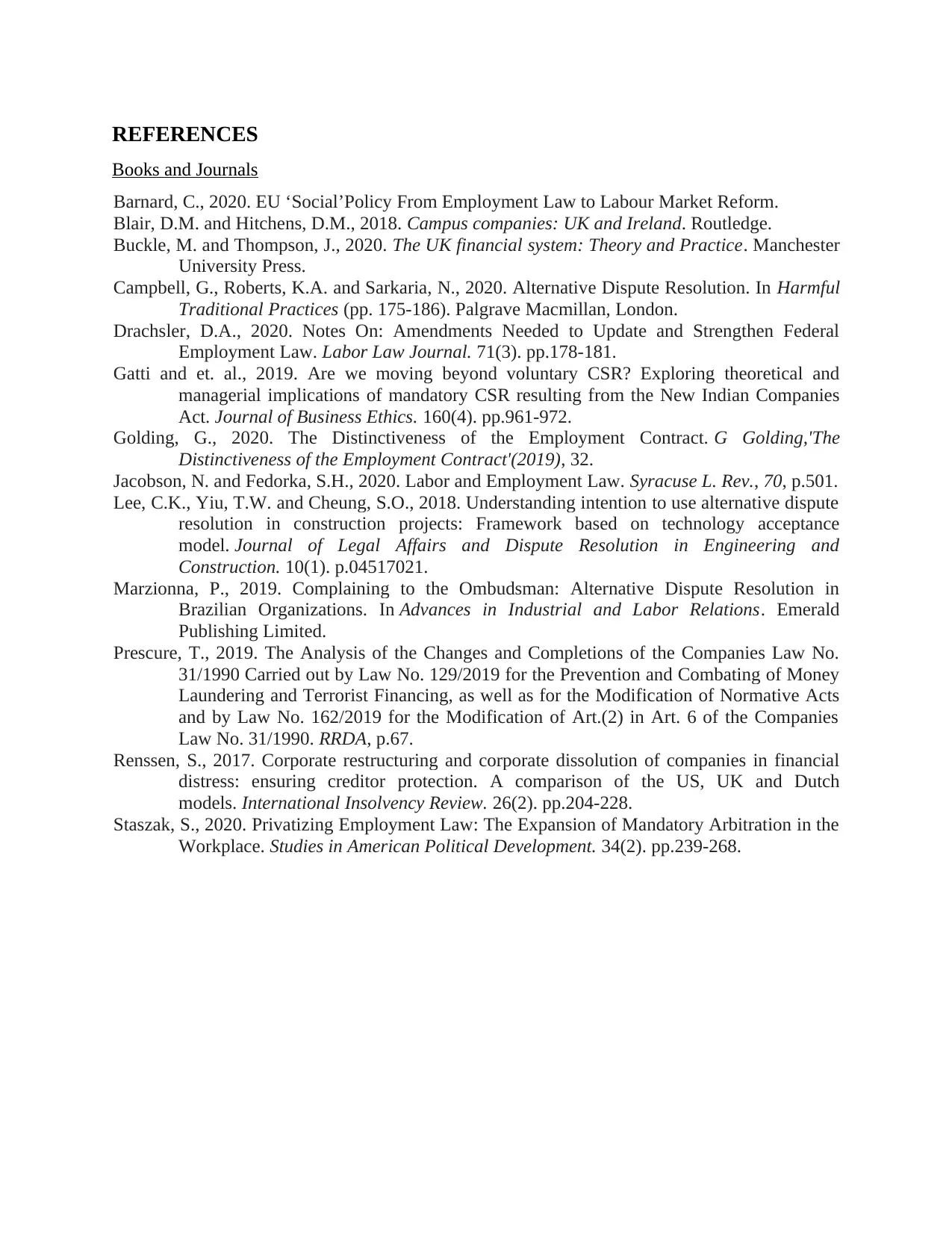
REFERENCES
Books and Journals
Barnard, C., 2020. EU ‘Social’Policy From Employment Law to Labour Market Reform.
Blair, D.M. and Hitchens, D.M., 2018. Campus companies: UK and Ireland. Routledge.
Buckle, M. and Thompson, J., 2020. The UK financial system: Theory and Practice. Manchester
University Press.
Campbell, G., Roberts, K.A. and Sarkaria, N., 2020. Alternative Dispute Resolution. In Harmful
Traditional Practices (pp. 175-186). Palgrave Macmillan, London.
Drachsler, D.A., 2020. Notes On: Amendments Needed to Update and Strengthen Federal
Employment Law. Labor Law Journal. 71(3). pp.178-181.
Gatti and et. al., 2019. Are we moving beyond voluntary CSR? Exploring theoretical and
managerial implications of mandatory CSR resulting from the New Indian Companies
Act. Journal of Business Ethics. 160(4). pp.961-972.
Golding, G., 2020. The Distinctiveness of the Employment Contract. G Golding,'The
Distinctiveness of the Employment Contract'(2019), 32.
Jacobson, N. and Fedorka, S.H., 2020. Labor and Employment Law. Syracuse L. Rev., 70, p.501.
Lee, C.K., Yiu, T.W. and Cheung, S.O., 2018. Understanding intention to use alternative dispute
resolution in construction projects: Framework based on technology acceptance
model. Journal of Legal Affairs and Dispute Resolution in Engineering and
Construction. 10(1). p.04517021.
Marzionna, P., 2019. Complaining to the Ombudsman: Alternative Dispute Resolution in
Brazilian Organizations. In Advances in Industrial and Labor Relations. Emerald
Publishing Limited.
Prescure, T., 2019. The Analysis of the Changes and Completions of the Companies Law No.
31/1990 Carried out by Law No. 129/2019 for the Prevention and Combating of Money
Laundering and Terrorist Financing, as well as for the Modification of Normative Acts
and by Law No. 162/2019 for the Modification of Art.(2) in Art. 6 of the Companies
Law No. 31/1990. RRDA, p.67.
Renssen, S., 2017. Corporate restructuring and corporate dissolution of companies in financial
distress: ensuring creditor protection. A comparison of the US, UK and Dutch
models. International Insolvency Review. 26(2). pp.204-228.
Staszak, S., 2020. Privatizing Employment Law: The Expansion of Mandatory Arbitration in the
Workplace. Studies in American Political Development. 34(2). pp.239-268.
Books and Journals
Barnard, C., 2020. EU ‘Social’Policy From Employment Law to Labour Market Reform.
Blair, D.M. and Hitchens, D.M., 2018. Campus companies: UK and Ireland. Routledge.
Buckle, M. and Thompson, J., 2020. The UK financial system: Theory and Practice. Manchester
University Press.
Campbell, G., Roberts, K.A. and Sarkaria, N., 2020. Alternative Dispute Resolution. In Harmful
Traditional Practices (pp. 175-186). Palgrave Macmillan, London.
Drachsler, D.A., 2020. Notes On: Amendments Needed to Update and Strengthen Federal
Employment Law. Labor Law Journal. 71(3). pp.178-181.
Gatti and et. al., 2019. Are we moving beyond voluntary CSR? Exploring theoretical and
managerial implications of mandatory CSR resulting from the New Indian Companies
Act. Journal of Business Ethics. 160(4). pp.961-972.
Golding, G., 2020. The Distinctiveness of the Employment Contract. G Golding,'The
Distinctiveness of the Employment Contract'(2019), 32.
Jacobson, N. and Fedorka, S.H., 2020. Labor and Employment Law. Syracuse L. Rev., 70, p.501.
Lee, C.K., Yiu, T.W. and Cheung, S.O., 2018. Understanding intention to use alternative dispute
resolution in construction projects: Framework based on technology acceptance
model. Journal of Legal Affairs and Dispute Resolution in Engineering and
Construction. 10(1). p.04517021.
Marzionna, P., 2019. Complaining to the Ombudsman: Alternative Dispute Resolution in
Brazilian Organizations. In Advances in Industrial and Labor Relations. Emerald
Publishing Limited.
Prescure, T., 2019. The Analysis of the Changes and Completions of the Companies Law No.
31/1990 Carried out by Law No. 129/2019 for the Prevention and Combating of Money
Laundering and Terrorist Financing, as well as for the Modification of Normative Acts
and by Law No. 162/2019 for the Modification of Art.(2) in Art. 6 of the Companies
Law No. 31/1990. RRDA, p.67.
Renssen, S., 2017. Corporate restructuring and corporate dissolution of companies in financial
distress: ensuring creditor protection. A comparison of the US, UK and Dutch
models. International Insolvency Review. 26(2). pp.204-228.
Staszak, S., 2020. Privatizing Employment Law: The Expansion of Mandatory Arbitration in the
Workplace. Studies in American Political Development. 34(2). pp.239-268.
1 out of 11
Related Documents
Your All-in-One AI-Powered Toolkit for Academic Success.
+13062052269
info@desklib.com
Available 24*7 on WhatsApp / Email
![[object Object]](/_next/static/media/star-bottom.7253800d.svg)
Unlock your academic potential
Copyright © 2020–2025 A2Z Services. All Rights Reserved. Developed and managed by ZUCOL.





